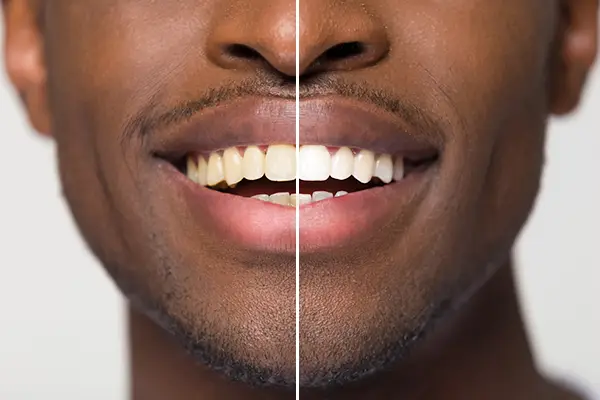Teeth Whitening Being one of the most popular treatments in cosmetic dentistry, teeth whitening offers a quick, affordable, and non-invasive way to enhance the glow of your smile. Technically, by the FDA definition of whitening, any product that is used to clean the teeth is considered a whitener. Being one of the most popular treatments in cosmetic dentistry, teeth whitening offers a quick, affordable, and non-invasive way to enhance the glow of your smile. Technically, by the FDA definition of whitening, any product that is used to clean the teeth is considered a whitener. When we talk about teeth whitening, it is usually referring to the treatment of using whitening products containing bleach, such as carbamide peroxide or hydrogen peroxide. There are a number of whitening treatments available at Town Center Dental. It is important to be aware that teeth whitening is not permanent. It can last a long time, however, if done in conjunction with lifestyle and habit changes. Bleaching treatmentsFor in-office bleaching, the preferred bleach is hydrogen peroxide. Hydrogen peroxide is fast-acting and concentrations range from nine to 40 percent. The most common bleach for at-home teeth whitening is carbamide peroxide. It is slower-acting and breaks down into hydrogen peroxide. Carbamide peroxide is about 30 percent as effective as hydrogen peroxide. Whichever you choose, your teeth may need multiple treatments to reach the desired shade of whiteness. Tooth enamel and dentinSparkling white teeth are protected by a hard, porcelain-like translucent tissue called enamel. Enamel is a fascinating tissue, it's the hardest tissue in the human body, harder than bone. Composed of microscopic crystalline rods, enamel protects the teeth from repeated chewing, gnashing, trauma, bacteria, and wear by sugars and acids. Dentin, the tooth's core layer, is inherently yellow in color. In some people, it can even be a greenish-gray shade. Over many years through repeated chewing, millions of microscopic cracks occur in our enamel. These cracks, as well as the spaces between the rods, fill up with stains and debris. As a result, the teeth begin to develop a dull appearance. As we age, dentin becomes more visible through the enamel. Tooth discoloration causesFirst, it's important we make the distinction between two types of staining: extrinsic and intrinsic. Extrinsic stains appear on the outside of the tooth, they can be easily removed with teeth brushing and dental cleaning. Intrinsic stains occur on the inside of the tooth and can form as a result in trauma, exposure to minerals during teeth development, or over ingestion of fluoride. In the past, dentists have thought intrinsic stains to be too resistant to bleach treatments. Cosmetic dentistry has since evolved, and dentists can now remove deep-set intrinsic stains by sending their patients home with whitening kits. Maintaining whitening over a month or even a year can yield significant whitening results. Translucency and thickness of tooth enamel are genetic traits that can affect people's teeth color and response to teeth whitening. Smoking and certain drugs or chemicals can also greatly affect teeth color. Habitual consumption of darkly colored foods can stain the teeth over time, so it is important to maintain good oral hygiene between meals. Risks of teeth whiteningOver half of patients who receive peroxide treatments report some level of gum irritation. This can last up to several days until the peroxide levels have subsided. Higher concentration bleaching can cause a temporary increase in tooth sensitivity. Individuals with gum recession are at higher risk of increased sensitivity. Restorations such as bonding or crowns are not affected by bleach and therefore maintain their color while the surrounding teeth are whitened. If you are considering a whitening treatment to brighten your smile, consult one of our dentists at . We can go over your past medical history, current oral health, and lifestyle habits to recommend the best plan for treatment and maintain its results. Call us at 636-273-5866 to schedule a consultation, or for more information. |